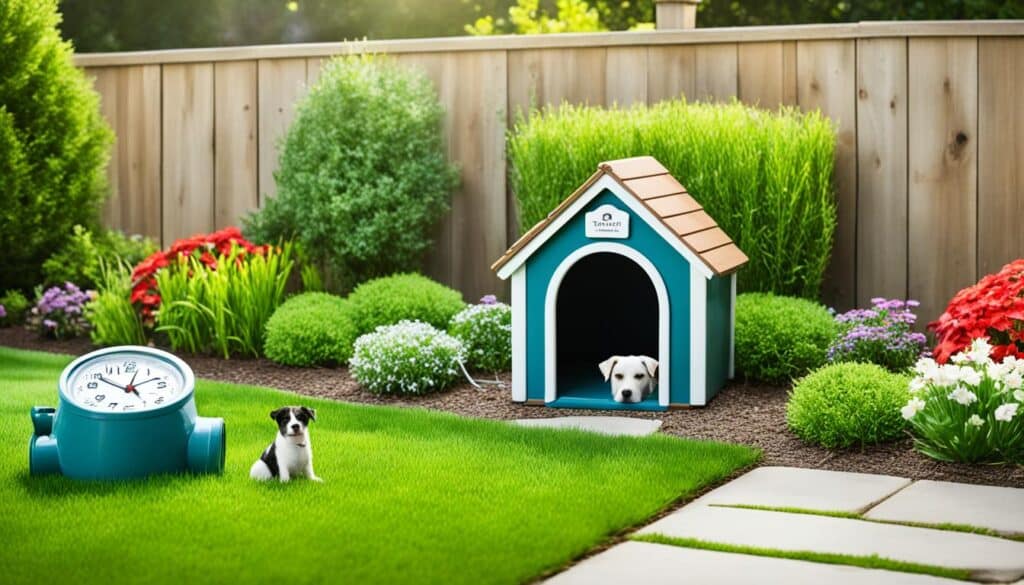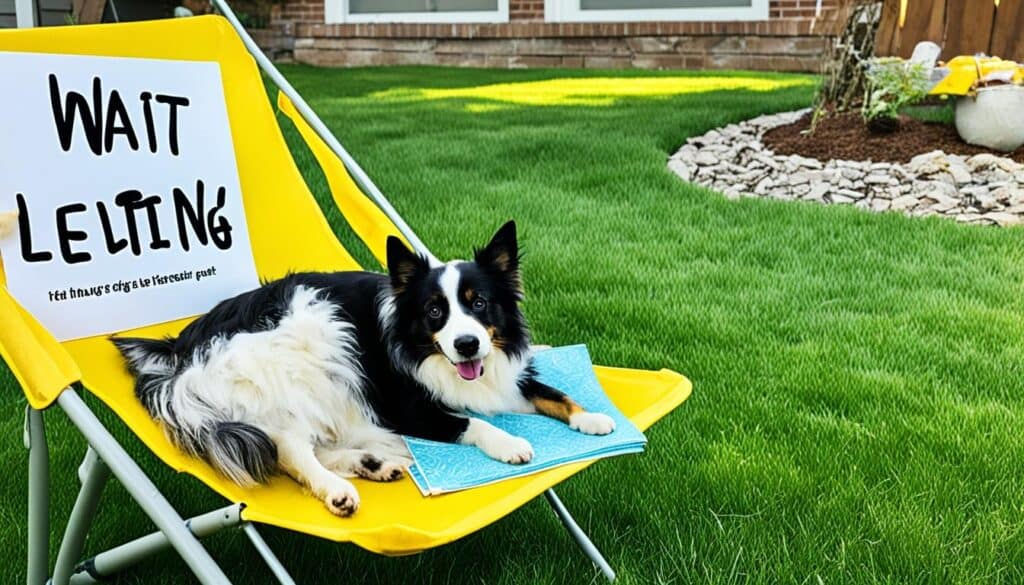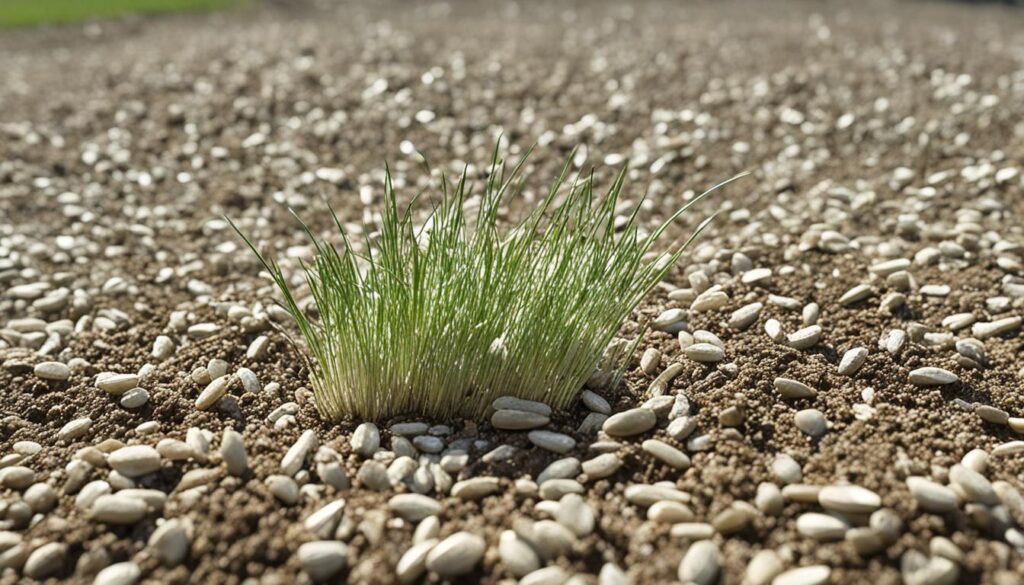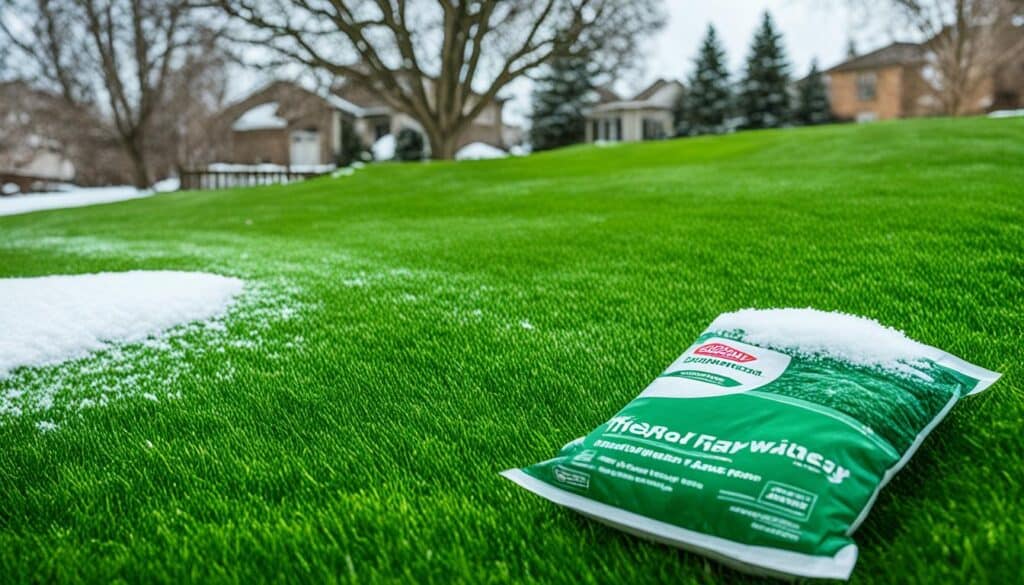Is it safe to let your furry friend play on the lawn right after treatment? Many pet owners think it’s okay once the lawn crew leaves. But, rushing your pet onto a freshly treated lawn can be dangerous. So, how long should you wait before letting pets on the lawn?
The answer is not simple. The type of chemicals used, the weather, and how they were applied affect pet safety. Knowing these factors is key to keeping your pets safe and healthy.
In this article, we’ll look at safe waiting times for pets after different lawn treatments. We’ll cover the risks of lawn chemicals to pets, signs of exposure, and how to keep your pet safe. By the end, you’ll know how to keep your lawn green and your pets safe.
Key Takeaways
- Wait 24-72 hours before letting pets on a treated lawn, depending on the type of treatment and weather conditions
- Liquid treatments dry faster than granular ones, but both require a waiting period for pet safety
- Organic fertilizers are safer but still need time to absorb into the lawn before letting pets roam freely
- Signs of pet exposure to lawn chemicals include gastrointestinal issues, respiratory problems, and skin irritation
- Precautionary measures like keeping pets indoors, watering the lawn, and cleaning paws can minimize risks
Understanding Lawn Treatment Products and Their Potential Risks to Pets
As a pet owner, knowing about lawn treatments and their risks to pets is key. Many lawn care products have chemicals that can harm pets if they eat them or touch them a lot. Knowing what’s in these products and their risks helps you keep your pet safe.
Types of Lawn Treatments and Their Ingredients
Lawn treatments have fertilizers, herbicides, insecticides, and pesticides. Each type helps keep lawns healthy and green. But, they also have chemicals that can be bad for pets if not used right.
- Fertilizers: These have nitrogen, potassium, and phosphorus to help grass grow. They’re usually safe but too much can upset a pet’s stomach.
- Herbicides: These kill weeds and can have glyphosate, linked to kidney disease and cancer. Atrazine, another herbicide, was banned in Europe for harming hormones.
- Insecticides and Pesticides: These fight bugs and pests and might have bifenthrin, seen as a possible cancer-causing chemical. Pets can get sick from these with vomiting, diarrhea, and breathing problems.
Potential Health Risks for Pets Exposed to Lawn Chemicals
Pets can get exposed to lawn chemicals by touching treated grass, eating it, or breathing in particles. The main health risks include:
- Gastrointestinal issues: Pets might vomit, have diarrhea, or not want to eat if they eat treated grass or soil.
- Respiratory problems: Pets can cough, wheeze, or have trouble breathing if they inhale chemical particles or vapors.
- Skin irritation and allergic reactions: Touching treated grass can irritate a pet’s skin, cause rashes, or allergic reactions.
- Increased cancer risk: A study found a 70% higher risk of a type of cancer in dogs linked to chemical lawn care.
A newsletter by beyondpesticides.org showed 30 common lawn pesticides have risks. 19 are linked to cancer, 13 to birth defects, and 21 to reproductive issues. 15 are neurotoxins, 26 harm liver or kidneys, 27 irritate or sensitize, and 11 affect hormones.
Knowing the risks of lawn chemicals helps pet owners keep their pets away from them. Choosing natural, pet-safe lawn care is a good idea.
Factors Affecting Waiting Times for Pet Safety
When deciding how long to wait before letting pets back on a treated lawn, consider several key factors. These factors help ensure your pets stay safe and healthy.
Type of Lawn Treatment Applied (Liquid or Granular)
The type of lawn treatment greatly affects waiting times for pet safety. Liquid treatments like fertilizers and herbicides need up to 48 hours to dry and soak into the soil. Granular treatments, however, usually only need about 24 hours, as long as no granules are left on the lawn.
| Lawn Treatment Type | Typical Waiting Time |
|---|---|
| Liquid Fertilizers | Up to 48 hours |
| Granular Fertilizers | Around 24 hours |
| Pet-Friendly or Organic Fertilizers | Shorter waiting times compared to treatments with pesticides |
Weather Conditions and Their Impact on Drying Time
Weather greatly affects how fast lawn treatments dry, which impacts pet safety waiting times. Sunny and warm weather speeds up drying, making it safer for pets sooner. But, cool, damp, or cloudy conditions slow down drying, so pets should wait longer before going back on the lawn.
As a general rule, it is recommended to wait 1-2 days before allowing pets back onto a fertilized lawn, depending on the absorption rate influenced by weather conditions.
Application Method and Coverage
The way you apply and how much of the lawn you treat also affects waiting times. Spot treatments for specific lawn areas might let pets back sooner. But, treating the whole lawn means waiting longer to make sure the product spreads and absorbs evenly.
Consider the treatment type, weather, and application method to figure out the right waiting time for your pets. Always play it safe and wait a bit longer to keep your pets out of harm’s way.
General Guidelines for Waiting Times After Lawn Treatments
Keeping your pet safe after a lawn treatment is key. Always wait for the products to dry and soak into the soil before letting your pets back on the grass. This reduces the risk of them coming into contact with harmful chemicals in fertilizers, herbicides, and pesticides.
The time you need to wait varies with the type of lawn treatment. Liquid treatments usually have shorter waiting times than granular ones. Experts suggest waiting 30 minutes to 5 hours after applying liquids, making sure they dry completely. Granular treatments, however, need more time, often 12 to 72 hours, to break down and be absorbed.
“As a general rule, it’s recommended to wait at least 24-72 hours after a lawn treatment before allowing pets back onto the grass. This waiting period ensures that the products have dried and been absorbed into the soil, minimizing the risk of pet exposure.”
Here are some key points on why waiting is crucial:
- The wait time for dogs after fertilizing can be 2 hours for liquids or at least 24 hours for granules.
- Products like Scotts weed and feed are not safe for dogs when the lawn is wet and should wait until it’s dry.
- After TruGreen applications, pets and kids should stay off the yard until it’s fully dry for safety.
Remember, waiting times can differ between products. Always check the label and talk to your lawn care service for the latest on pet safety. By following these guidelines and product advice, you can protect your pets and keep your lawn looking great.
How Long After Lawn Treatment Is It Safe for Pets?
The safety of pets after lawn treatments depends on the type of product used. Liquid and granular fertilizers, herbicides, and insecticides all have different drying times. These times affect when pets can safely return to the lawn.
Liquid Fertilizers and Herbicides
Liquid fertilizers and herbicides dry quickly, usually in 2 to 4 hours. In hot weather, they can dry in just 20 minutes. Always wait until the spray has fully dried before letting pets back on the lawn.
Granular Fertilizers and Herbicides
Granular products take longer to be safe for pets. They need to soak into the soil, which takes about 24 hours. Heat can speed up this process, but it’s safest to wait 24 hours before letting pets on the lawn.
| Type of Lawn Treatment | Typical Drying Time | Recommended Waiting Period |
|---|---|---|
| Liquid Fertilizers | 2-4 hours | Until dry |
| Liquid Herbicides | 2-4 hours | Until dry |
| Granular Fertilizers | 24 hours | 24 hours after watering in |
| Granular Herbicides | 24 hours | 24 hours after watering in |
Insecticides and Pesticides
Insecticides and pesticides have different waiting times. Some need 24-48 hours or more to be safe for pets. Always check the product label and follow the instructions. If unsure, ask your lawn care provider for advice.
The company provides instructional videos after each yard visit to inform customers on how long to avoid the area, when to water, and what to expect from the treatment.
For your pet’s safety, follow the recommended waiting times for each product. Knowing the differences between liquid and granular products helps you keep your pets safe while maintaining a healthy lawn.
Signs and Symptoms of Pet Exposure to Lawn Chemicals
As a pet owner, knowing the signs of pet exposure to lawn chemicals is key. Symptoms vary by chemical type and how much your pet has been exposed to. Watch for unusual behavior or physical signs if you think your pet has been exposed to lawn treatments.
Gastrointestinal Issues (Vomiting, Diarrhea, Loss of Appetite)
Pets often show signs of stomach problems after being exposed to lawn chemicals. They might vomit, have diarrhea, or stop eating. These symptoms can start within minutes or a few days after exposure, based on the chemical and amount consumed.
The ASPCA Animal Poison Control Center says pesticide poisoning is a top issue in pets, including dogs. If your pet has these stomach problems after being on a treated lawn, call your vet right away.
Respiratory Problems (Coughing, Wheezing, Difficulty Breathing)
Lawn chemicals can also cause breathing issues in pets. Symptoms like coughing, wheezing, and trouble breathing can happen if pets inhale chemical fumes. These problems can be worse if pets are exposed to a lot of certain chemicals, like phenoxyacetic compounds used in lawn care.
A study found pets can be exposed to herbicides even on lawns not treated with them, showing the risks pets face.
Skin Irritation and Allergic Reactions
Skin problems and allergic reactions are signs of pet exposure to lawn chemicals too. Pets may get red, itchy skin, or rashes if they touch treated grass or surfaces. Chemicals like benzoic acid herbicides can irritate skin if pets are exposed to a lot.
To lower the chance of skin problems, keep pets off treated areas until the chemicals dry. Clean your pet’s paws and fur after being outside to remove chemicals.
| Symptom Category | Specific Symptoms |
|---|---|
| Gastrointestinal Issues | Vomiting, Diarrhea, Loss of Appetite |
| Respiratory Problems | Coughing, Wheezing, Difficulty Breathing |
| Skin Irritation and Allergic Reactions | Redness, Itching, Rashes |
If you see these signs in your pet after lawn chemical exposure, call your vet right away. They can tell you what to do next to keep your pet safe and healthy.
Precautionary Measures to Ensure Pet Safety
As a responsible pet owner, it’s key to keep your furry friends safe from lawn chemicals. By taking simple steps, you can lower the risk of your pets getting hurt. This keeps them healthy.

Keeping Pets Indoors During and After Lawn Treatments
Keeping your pets inside is a great way to protect them from lawn chemicals. It stops them from touching the chemicals and reduces the chance of them eating or breathing them in. Keep your pets inside for 24-48 hours after using granular fertilizers. Wait until the treated area is dry if you use liquids.
Thoroughly Watering the Lawn to Dilute Chemicals
After using granular fertilizers or herbicides, water your lawn well. This spreads out the chemicals and helps them soak into the soil. This lowers the risk of your pets touching strong chemicals. Always follow the product’s instructions on how much water to use and when it’s safe for your pets to go back on the lawn.
| Product Type | Recommended Waiting Time |
|---|---|
| Liquid fertilizers and herbicides | Until the treated area is completely dry (typically 2 hours or more) |
| Granular fertilizers (conventional release) | 24-48 hours after application and watering |
| Granular fertilizers (controlled release) | At least 24-48 hours after application and watering |
| Specialty products (e.g., Sportsmaster Renovator Pro, Cleanrun Pro) | 5-7 days after granules disperse into the base of the sward |
Removing Pet Waste and Cleaning Paws After Outdoor Activities
Even after waiting, it’s important to keep your pet safe from lawn chemicals. Always pick up pet waste right away to keep it from spreading. Clean your pet’s paws after they’ve been outside to stop them from eating chemicals while they clean themselves.
If you think your pet has touched lawn chemicals and is sick, call your vet or the Pet Poison Helpline at 1-800-213-6680 right away.
By taking these steps and knowing about the products you use on your lawn, you can make a safer place for your pets. You can also have a beautiful, healthy yard to enjoy with them.
Alternatives to Traditional Lawn Treatments for Pet-Friendly Lawns
Pet owners can find safer lawn care options. Organic products like compost and seaweed are great for pets. They feed the soil without harmful chemicals.
Using organic fertilizers is just the start. Natural lawn care also helps. It makes your lawn green and cuts down on chemicals.
- Proper mowing techniques, such as cutting grass to the appropriate height and leaving clippings on the lawn to decompose and nourish the soil
- Regular aeration to improve soil structure and promote healthy root growth
- Overseeding to fill in bare spots and maintain a dense, weed-resistant lawn
- Mulching to retain moisture, suppress weeds, and regulate soil temperature
- Utilizing natural weed control methods, such as manual removal, organic mulch, or corn gluten meal
Experts say organic fertilizers are best for pet-friendly lawns. They should have no harmful chemicals.
When using pet-safe lawn care, apply it right and wait. Wait 24 hours before pets go back on the lawn. This lets the fertilizer soak in safely.
| Organic Lawn Fertilizer | Application Frequency | Waiting Time for Pets |
|---|---|---|
| Compost | 2-4 times per year | 24 hours |
| Grass Clippings | After each mowing | None (if from untreated lawn) |
| Fish Emulsion | 2-4 times per year | 24 hours |
| Bone Meal | 2-4 times per year | 24 hours |
Talk to a lawn care pro for organic or natural advice. They can give you tips for your lawn and pets. With these alternatives and natural care, your pets can safely enjoy your lawn.
Working with Your Lawn Care Provider to Ensure Pet Safety
Keeping your pets safe while having a beautiful lawn is key. Talking with your lawn care provider is vital. A good partnership means your lawn gets the care it needs without harming your pets.

Communicating Your Pet’s Presence and Concerns
Tell your lawn care provider about your pets. Share any worries you have about the treatments and products they use. A good provider will listen and help find safe solutions for your pets and a great lawn.
The company emphasizes the importance of open communication between pet owners and lawn care providers to address concerns about pet safety during lawn treatments.
Inquiring About Pet-Safe Product Options
Ask your provider about pet-safe products for lawn care. Many companies have products that are safe for pets but still work well. These might be organic or natural options that don’t use harsh chemicals.
- Pet safe lawn care promotes the use of minimal herbicides by targeting individual weeds.
- Use of pet-safe lawn fertilizer is recommended to avoid grass burns from excess nitrogen found in standard lawn fertilizers.
Following Your Provider’s Recommendations for Waiting Times
After treatment, wait as long as your provider suggests before letting pets on the lawn. These times vary by product and provider’s knowledge. Usually, it’s safe for pets once the lawn is dry, which can be a few minutes to a couple of hours.
| Product Type | Typical Drying Time | Recommended Waiting Time |
|---|---|---|
| Liquid treatments | 30 minutes to 1 hour | 1-2 hours |
| Granular treatments | No drying time | Immediately after watering in |
Follow your provider’s advice and take steps like keeping pets inside during treatments and removing toys from the lawn. This lowers the risk of pets getting to lawn chemicals.
A trusted lawn care provider helps you have a beautiful, safe lawn for your pets. Don’t be shy to ask questions, share concerns, and work together to find the best solutions for your situation.
What to Do If Your Pet Is Exposed to Lawn Chemicals
If you think your pet has touched lawn chemicals, act fast to lessen harm. There are over 1,700 pesticide products out there. Pets often get sick from eating these products. Knowing what to do is key.
First, move your pet away from the treated area. Check them for any signs of chemicals on their fur, skin, or paws. Clean them well with water. Remember, pets can show signs of poisoning within minutes.
Look out for these signs of pesticide poisoning in pets:
- Excessive drooling
- Skin irritation
- Vomiting
- Seizures
- Breathing difficulties
If your pet shows any bad signs, call your vet right away. Tell them about the lawn treatment you used. For emergencies, call the Poison Control hotline at 1-800-222-1222.
Dogs can get sick from insecticides by walking on treated lawns, eating treated grass, or eating bugs sprayed with chemicals.
Most dogs get better from pesticide poisoning with quick care. But, it’s best to prevent it. Here are some ways to lower the risk:
| Prevention Tip | Description |
|---|---|
| Secure garden products | Keep all pesticides and lawn chemicals away from your pet |
| Clean up treated areas | Remove dead insects and contaminated spots from your lawn |
| Follow label directions | Use the products as the label says, including waiting times |
| Use pet-friendly products | Choose safer pesticides or natural options when you can |
Acting fast and taking steps to protect your pet can keep them safe. Always ask your vet for advice if you’re unsure.
Conclusion
Keeping your pets safe from lawn treatment dangers needs you to act first and know the risks. Learn about the chemicals in lawn care products and their dangers. This knowledge helps you make choices to protect your pets.
It’s key to follow lawn treatment waiting times. These times show when the chemicals are less dangerous. Keeping pets inside during and right after treatments is a good step. Also, rinse your pet’s paws after they’ve been outside.
Even after waiting, chemicals might still be on the grass and could harm your pet. Watch for signs like vomiting, diarrhea, tiredness, or skin issues. If you see these, call your vet right away.
Work with your lawn care service to find pet-safe options. Follow their advice to keep your lawn nice and your pets safe. With the right info and care, you can make a safe outdoor space for everyone.
FAQ
How long should I wait before allowing my pet back onto the lawn after a treatment?
It’s best to wait 24-72 hours before letting pets back on the lawn. This time lets the products dry and soak into the soil. It lowers the risk of pets getting exposed. But, the exact time can change based on the product and the maker’s advice.
What are the potential health risks for pets exposed to lawn chemicals?
Pets can face health issues like stomach problems (vomiting, diarrhea, not eating), breathing issues (coughing, wheezing, hard breathing), skin irritation, and allergic reactions. Knowing these risks helps keep pets safe.
What factors affect the waiting time for pet safety after a lawn treatment?
Waiting times vary by treatment type (liquid or granular), weather, and how it was applied. Liquids dry faster than granules, and sunny days dry them quicker than cloudy ones.
Are there any pet-friendly alternatives to traditional lawn treatments?
Yes, there are safe alternatives. Organic products like corn gluten meal or neem oil help keep lawns healthy with fewer chemicals. Using natural care methods, like proper mowing and aeration, also helps without chemicals.
What should I do if my pet has been exposed to lawn chemicals?
Move your pet away from the treated area and stop them from getting more exposed. Clean off any chemicals on their fur, skin, or paws with water. Watch them for illness signs and call a vet if symptoms are bad.



